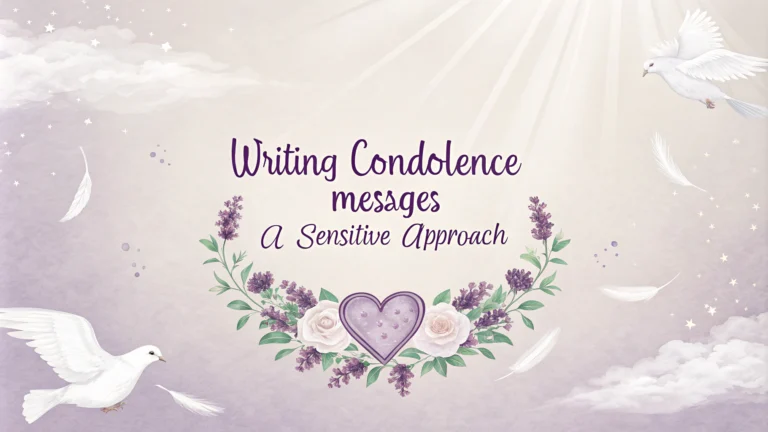Writing a heartfelt condolence message can feel overwhelming during times of loss.
This guide helps you express your sympathy with grace and sincerity.
Key Elements of a Condolence Message
- Acknowledge the loss directly
- Share a specific memory if you have one
- Offer specific help rather than vague support
- Express your sympathy genuinely
- Close with a thoughtful sentiment
Sample Condolence Message Templates
What to Avoid
- Comparing losses or grief experiences
- Using phrases like “everything happens for a reason”
- Making religious references unless you know they’re appropriate
- Writing lengthy messages when simpler ones suffice
Timing Considerations
- Send your message within two weeks of learning about the loss
- Follow up with another note a month later
- Remember significant dates like birthdays or anniversaries
Different Ways to Send Condolences
- Handwritten note (most personal)
- Sympathy card
- Email (when immediate response needed)
- Text message (close relationships only)
Appropriate Actions to Accompany Your Message
- Send flowers (check cultural appropriateness)
- Make a donation to a meaningful cause
- Prepare or send meals
- Offer practical help with specific tasks
Consider cultural and religious customs when expressing condolences.
Quick Tips for Writing
- Write from the heart
- Keep it simple and sincere
- Focus on the bereaved person’s needs
- Proofread carefully
Remember that your presence and support matter more than perfect words.
Additional Support Resources
- GriefShare: www.griefshare.org
- National Hospice and Palliative Care Organization: www.nhpco.org
Cultural Considerations
- Research cultural mourning traditions
- Respect religious beliefs and practices
- Consider appropriate mourning periods
- Ask others familiar with the culture if unsure
Following Up After Initial Condolences
- Schedule regular check-ins
- Mark important dates on your calendar
- Share additional memories as they come to mind
- Continue offering practical support
Long-Term Support Ideas
- Create memory books or photo collections
- Organize memorial gatherings
- Help with ongoing responsibilities
- Include them in holiday celebrations
Digital Condolence Etiquette
- Avoid public social media posts unless requested
- Send private messages instead of public comments
- Respect the family’s privacy preferences
- Consider time zones when sending messages
Conclusion
Expressing condolences is about showing support and care during difficult times. While finding the right words may feel challenging, sincere and thoughtful messages can provide comfort to those grieving. Remember that your consistent presence and support often mean more than any perfectly crafted message.
Whether through written words or practical actions, your efforts to reach out make a meaningful difference in someone’s grieving journey. Stay genuine, be present, and offer continued support as they navigate their loss.
FAQs
1. What are the essential elements of a thoughtful condolence message?
Acknowledge the loss specifically, express your sincere sympathy, share a positive memory of the deceased if possible, offer specific support, and close with a comforting phrase.
2. Is it appropriate to send condolences through text or social media?
While a handwritten note is traditionally preferred, modern communications like text or social media are acceptable, especially for close friends. However, formal written condolences should follow for immediate family members.
3. How long after a death is it appropriate to send a condolence message?
Ideally, send condolences within two weeks of learning about the death, but it’s never too late to express sympathy. Late condolences can actually be meaningful, showing the deceased is still remembered.
4. What phrases should be avoided in condolence messages?
Avoid phrases like “I know how you feel,” “They’re in a better place,” “Everything happens for a reason,” or “Be strong.” These can minimize the grieving person’s feelings or impose religious views.
5. Should you share personal grief experiences in a condolence message?
Generally, keep references to your own grief experiences minimal. The focus should remain on the bereaved person’s loss and their loved one.
6. What’s appropriate to say when someone loses a spouse?
Acknowledge the depth of their loss, mention specific qualities of their spouse, and recognize the length and significance of their relationship. Offer concrete help with daily tasks.
7. How should you write condolences for the loss of a child?
Be especially gentle and acknowledge that there are no words adequate for such a loss. Mention the child by name and offer specific memories if you have them. Avoid platitudes or silver linings.
8. Is it appropriate to include humorous memories in a condolence message?
If you knew the deceased well and they were known for their sense of humor, sharing a light memory can be appropriate, but use careful judgment and keep the overall tone respectful.
9. Should religious references be included in condolence messages?
Only include religious references if you’re certain about the recipient’s religious beliefs. Otherwise, stick to non-religious expressions of sympathy and support.
10. How do you close a condolence message appropriately?
End with phrases like “With deepest sympathy,” “Thinking of you,” or “With caring thoughts.” Avoid overly casual closings and offer specific ways you’ll provide support if applicable.







